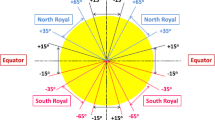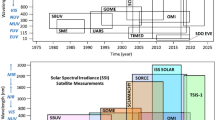Abstract
The Total Solar Irradiance (TSI) primarily varies on an 11-year time scale and is governed by features such as sunspots and associated decay products such as plage and faculae. These short-lived physical features can also modulate the solar irradiance at intermediate and short temporal scales. Here we investigate the periodic variations, at solar-surface-rotation time scales, of photometric indices derived from images obtained at the San Fernando Observatory (SFO), and we compare them to the properties of the contemporaneous TSI as measured by the Total Irradiance Monitor (TIM) onboard the SOlar Radiation and Climate Experiment (SORCE) spacecraft. Both the daily ground- and space-based data, which span from early 2003 to late 2018, present missing pixels. We use an autoregressive gap-filling method to construct continuous time series to be analyzed via Fourier and wavelet spectral techniques. Lomb–Scargle periodograms, which can handle time series with missing data, are used for comparison. Both the Fourier spectral power and the periodograms yield compatible results with statistically significant periodicities in the range 25 – 35 days. All of the time series have maximum power at 27 days. Significant secondary periods are found at 29 – 30 days and 34 – 35 days. Wavelet analyses of the full time series show that the photometric index resulting from the red-continuum photometric sum \([\Sigma _{\mathrm{{r}}}]\) and the TSI exhibit common high power at surface-solar-rotation scales during the active part of the solar cycle. The phase relation at the surface-solar-rotation scales is not definite. During the solar minimum interval between Solar Cycles (SCs) 23 and 24, variations in the TSI are found to be related to variations both in the photometric index \(\Sigma _{\mathrm{{K}}}\), calculated from Ca ii K-line photometric sums and in the magnetic flux in the solar activity latitudinal band (as found in previous work). This suggests that the TSI changes during the minimum are caused by the reduced line-blanketing effect of diffused magnetic field.








Similar content being viewed by others
References
Agee, E., Cornett, E., Gleason, K.: 2010, J. Climate23, 6110. DOI .
Beck, J.G., Chapman, G.A.: 1993, Solar Phys.146, 49. DOI . ADS .
Benevolenskaya, E.E., Kostuchenko, I.G.: 2013, J. Astrophys.2013, 368380. DOI .
Chang, C., Glover, G.H.: 2010, NeuroImage50, 81. DOI .
Chapman, G.A., Cookson, A.M., Preminger, D.G.: 2012, Solar Phys.276, 35. DOI . ADS .
Chowdhury, P., Khan, M., Ray, P.C.: 2009, Mon. Not. Roy. Astron. Soc.392, 1159. DOI . ADS .
de Toma, G., White, O.R., Chapman, G.A., Walton, S.R., Preminger, D.G., Cookson, A.M.: 2004, Astrophys. J.609, 1140. DOI . ADS .
Domingo, V., Ermolli, I., Fox, P., Fröhlich, C., Haberreiter, M., Krivova, N.A., Kopp, G., Schmutz, W., Solanki, S.K., Spruit, H.C., Unruh, Y., Vögler, A.: 2009, Space Sci. Rev.145, 337. DOI . ADS .
Fröhlich, C., Lean, J.: 1998, Geophys. Res. Lett.25, 4377. DOI . ADS .
Fröhlich, C., Lean, J.: 2004, Astron. Astrophys. Rev.12, 273. DOI . ADS .
Grinsted, A., Moore, J.C., Jevrejeva, S.: 2004, Nonlinear Process. Geophys.11, 561. ADS .
Harvey, K.L., White, O.R.: 1999, Astrophys. J.515, 812. DOI . ADS .
Horne, J.H., Baliunas, S.L.: 1986, Astrophys. J.302, 757. DOI . ADS .
Kopp, G.: 2016, J. Space Weather Space Clim.6, A30. DOI . ADS .
Lean, J.L., Cook, J., Marquette, W., Johannesson, A.: 1998, Astrophys. J.492, 390. DOI . ADS .
Lee, J.N., Cahalan, R.F., Wu, D.L.: 2015, J. Atmos. Solar-Terr. Phys.132, 64. DOI . ADS .
Li, K.J., Xu, J.C., Liu, X.H., Gao, P.X., Zhan, L.S.: 2010, Solar Phys.267, 295. DOI . ADS .
Mekaoui, S., Dewitte, S.: 2008, Solar Phys.247, 203. DOI . ADS .
Orfanidis, S.J.: 1996, Optimum Signal Processing: An Introduction, 2nd edn. McGraw-Hill, New York.
Ortiz, A., Rast, M.: 2005, Mem. Soc. Astron. Ital.76, 1018. ADS .
Preminger, D.G., Chapman, G.A., Cookson, A.M.: 2011, Astrophys. J.739, L45. DOI . ADS .
Preminger, D.G., Walton, S.R., Chapman, G.A.: 2001, Solar Phys.202, 53. DOI . ADS .
Preminger, D.G., Walton, S.R., Chapman, G.A.: 2002, J. Geophys. Res.107, 1354. DOI . ADS .
Rast, M.: 2003, Local and global helioseismology: the present and future. In: Sawaya-Lacoste, H. (ed.) Proc. SOHO 12 / GONG+ 2002SP-517, ESA, Noordwijk, 163. ADS .
Rast, M.P., Ortiz, A., Meisner, R.W.: 2008, Astrophys. J.673, 1209. DOI . ADS .
Schrijver, C.J., Harvey, K.L.: 1989, Astrophys. J.343, 481. DOI . ADS .
Solanki, S.K., Krivova, N.A., Haigh, J.D.: 2013, Annu. Rev. Astron. Astrophys.51, 311. DOI . ADS .
Solanki, S.K., Unruh, Y.C.: 2013, Astron. Nachr.334, 145. DOI . ADS .
Torrence, C., Compo, G.P.: 1998, Bull. Am. Meteorol. Soc.79, 61. DOI . ADS .
Torrence, C., Webster, P.J.: 1999, J. Climate12, 2679. DOI . ADS .
Walton, S.R., Chapman, G.A., Cookson, A.M., Dobias, J.J., Preminger, D.G.: 1998, Solar Phys.179, 31. DOI . ADS .
White, O.R., Livingston, W., Penn, M.: 2010, Extended Abstracts, SORCE Science Meeting, 6B. lasp.colorado.edu/sorce/news/2010ScienceMeeting/doc/Session6/6b_White_Livingston_i.pdf .
Woods, T.N.: 2010. In: Cranmer, S., Hoeksema, T., Kohl, J. (eds.) SOHO-23: Understanding a Peculiar Solar MinimumCS-428, Astron. Soc. Pacific, San Francisco, 63. ADS .
Xu, J.C., **e, J.L., Qu, Z.N.: 2017, Astrophys. J.851, 141. DOI . ADS .
Yeo, K.L., Solanki, S.K., Norris, C.M., Beeck, B., Unruh, Y.C., Krivova, N.A.: 2017, Phys. Rev. Lett.119, 091102. DOI . ADS .
Acknowledgments
We are very grateful to the anonymous reviewer whose comments and suggestions have led to substantial improvements in the article. We thank the SORCE mission for making the data available to the community. This work was supported in part by grants AGS-1429757 and AGS-1620647 from NSF, 80NSSC 18K-1328 from NASA, and subcontract 1552658 from LASP.
Author information
Authors and Affiliations
Corresponding author
Ethics declarations
Disclosure of Potential Conflicts of Interest
The authors declare that they have no conflicts of interest.
Additional information
Publisher’s Note
Springer Nature remains neutral with regard to jurisdictional claims in published maps and institutional affiliations.
This article belongs to the Topical Collection:
Irradiance Variations of the Sun and Sun-like Stars
Guest Editors: Greg Kopp and Alexander Shapiro
Rights and permissions
About this article
Cite this article
Choudhary, D.P., Cadavid, A.C., Cookson, A. et al. Variability in Irradiance and Photometric Indices During the Last Two Solar Cycles. Sol Phys 295, 15 (2020). https://doi.org/10.1007/s11207-019-1559-7
Received:
Accepted:
Published:
DOI: https://doi.org/10.1007/s11207-019-1559-7




